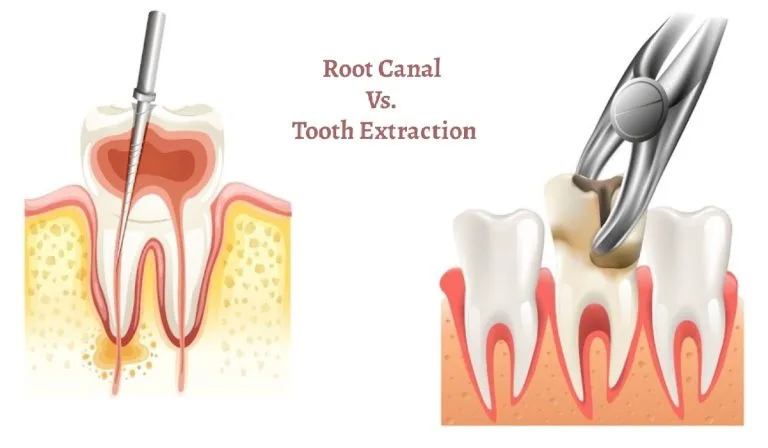Picture the moment you wake up—whether it’s to a throbbing tooth, a swollen jaw, or either that’s made it uncomfortable to sip a hot beverage—you’re at a point of decision: root canal therapy or tooth extraction. Both of these procedures are intended to eliminate your pain and restore your oral health, but they do take substantially different approaches.
The aim of root canal therapy is to keep your natural tooth while removing the infection; the aim of tooth extraction is to remove your specific problem completely, but that comes with its own costs and recovery needs.
It may be beneficial for you to think about things like the cost of a root canal vs. dental extraction, or the concerns regarding recovery from a root canal vs. recovery following an extraction. Understanding the considerations around a root canal and an extraction can allow you to inform your decision with a sense of confidence.
Let’s dive into both options so that you can be prepared to make a decision in collaboration with your dentist, because your smile is worth it.
What Is a Root Canal?
A root canal is used in dentistry to remove infectious material from a tooth by extracting the inflamed and infected pulp from within the tooth. Within the pulpal chamber, the inner tooth chamber is cleaned thoroughly after recovery of the pulp, disinfected. and completed with a filling or a restore to strengthen and function for the tooth.
This procedure will likely be recommended while the tooth structure is still intact and able to be saved. Generally, through technology and medical practice, pain is minimal and relatively manageable, resulting in a quick recovery with proper maintenance. Essentially, if a root canal is successful, it allows your tooth to remain in your mouth as it removes the disease at its source.
What Is a Tooth Extraction?
A tooth extraction is when a severely decayed, damaged, or problematic tooth is removed from its socket. Dentists typically recommend this procedure when the tooth is unrepairable or when it poses a risk to nearby teeth and/or the oral environment as a whole.
While extracting the tooth may relieve the problem, this often necessitates follow-up restorative work, such as a dental implant or bridge, to restore the normal bite and appearance of the dentition.
During the healing phase, there is a short time of recovery which is crucial in terms of post-extraction care in order to prevent pain or infection. While extracting the tooth may be the more permanent solution, it carries its own long-term, oral health implications.
Root Canal vs Tooth Extraction: Pros and Cons
When you are faced with the option of either a root canal or a tooth extraction, knowing the pros and cons of both is helpful when selecting the best choice for your oral health, comfort, and long-term health.
While both root canal therapies and extractions resolve the pain and infection, the procedures and their outcomes vary significantly in goals of treatment, recovery, and longevity in your mouth. Below is a simplified comparison to help you know what you are discussing with your dentist:
|
Factor |
Root Canal | Tooth Extraction |
| Tooth preservation | Keeps natural tooth | Tooth is removed |
| Pain after procedure | Mild to moderate | Moderate to severe (initially) |
| Cost | Higher (short-term) | Lower (short-term) |
| Long-term impact | Prevents bone loss | May lead to shifting or bone loss |
| Recovery time | Shorter | Slightly longer |
Whether you choose root canal vs tooth extraction will depend on a variety of factors, including the condition of the tooth, your overall dental health, and your future goals. Thus, it is important to weigh both the immediate and long-term consequences of each option.

When Is a Root Canal Better?
A root canal is generally the best option for preserving your natural tooth if it is reasonable and practical to do so. This is beneficial because it relieves the infection in the tooth and allows for the restoration of the form and function of your smile without replacement options. Root canals are best in the following situations:
- The tooth has not been destroyed structurally: The outer tooth structure is still intact for a filling or crown to be placed after treatment.
- There is no major fracture or root issues: Providing the root is still there and healthy, it makes sense to keep it here, rather than extracting it.
- The patient wants to avoid prosthetics: By keeping your tooth, you avoid needing bridges, dentures, or implants.
- Long-term oral health: Root canals allow proper alignment of the bite, as well as prevent bone loss that could contribute to other issues leading to tooth loss.
Deciding to have a root canal may not only solve the current problem, but be a long-term commitment to comfort and function.
When Is Extraction the Better Option?
Although it may be desirable in many cases to hold onto a natural tooth, there are times when extraction is ultimately the preferred and necessary treatment option.
Whenever damage is greater than repair, or other treatment options fail, extraction can limit additional complications while allowing for successful restoration. Extraction is usually best thought of in the following situations:
- Severe damage or fracture below the gumline: If the tooth structure has been compromised to a point of non-repair, then it would be impossible to save.
- Repeated failed root canal therapies: When prior treatment options have not been successful in fixing the issue, extraction seems to offer a more final answer.
- Cost prohibitive or insurance issues: In certain cases, extraction may be a less expensive option in the short-term for patients with financial issues or limited insurance coverage.
- Preparation for dentures or other implants: If the extraction is part of a larger treatment plan to restore full-mouth rehabilitation, extraction is sometimes necessary.
In these cases, extraction may help to preserve your overall oral health and may be the start of long-term success in treatment.
What Happens After Each Procedure?
Knowing what to expect during and after treatment is just as important as what has occurred during the procedure. Regardless of whether a tooth has been removed or a root canal was delivered, how each option is cared for and related to the next few days and years will be essential for the patient’s oral comfort and function. Here is how a root canal, versus extraction, is followed up:
- Following a root canal: Once the infection has been cleaned from the tooth, your dentist will strongly recommend a crown to protect and restore the strength of your tooth. Healing is typically relatively easy and uncomplicated with very little discomfort.
- Following a tooth extraction: Patients will care for the empty socket, in order to prevent issues such as dry socket and ensure healing. Patients will need to avoid certain activities and follow certain care instructions in the initial healing stage.
- Replacing the missing tooth: In the event of tooth extraction, a treatment plan must be considered to replace the tooth – either with an implant or a bridge. Tooth movement, bone loss, and bite issues will occur if there are not options considered for the missing tooth.
Both options require some after care – however, extraction includes additional steps for subsequent restoration of function and appearance.
Cost Comparison: Root Canal vs Extraction
When choosing between a root canal and tooth extraction, we often think about price. Extracting the tooth usually has a lower price tag upfront, but after you factor in replacing the tooth (e.g., implant or bridge) the total price for tooth extraction may escalate quickly.
Conversely, a root canal, while more costly upfront, saves the natural tooth and will reduce your out-of-pocket expenses on restorations. Here’s the cost difference to help financially prepare:
| Treatment | Approximate Cost (USD) |
| Root Canal + Crown | $700–$2,000 |
| Simple Extraction | $75–$300 |
| Surgical Extraction | $150–$650 |
| Implant (if needed) | $2,000–$4,000 |
Extracting your tooth may seem cheaper in the beginning, but adding a replacement tooth doubles your long-term expenses and is why it is vital to consider your short- and long-term savings before deciding for your dental needs.

Talk to Your Dentist: Personalized Recommendations Matter
It is important to see your dentist for a full assessment that is specific to your situation before deciding whether to proceed with a root canal or extraction of a tooth. In most cases, both a dental X-ray and a comprehensive oral examination are required to collect and evaluate information about your tooth, surrounding bone and treatment viability.
It is never a one size fits all situation – every person has a personal set of determinants (personal budget, long term oral health goals, comfort level with discussions related to the permanence of treatment and their future plans for dental care) that influence their decision. This is why a professional recommendation from a dentist makes sense!
When you visit your dentist, consider asking these questions:
- Is the remaining structure of the tooth strong enough to restore with a root canal?
- What are the long term consequences of removing the tooth?
- If I have the tooth extracted, will I need to have an implant or bridge at a later date?
- What is the overall cost and insurance coverage for each option?
- How will each option affect my total dental health?
Open questions with your dentist will leave you feeling confident and informed about making the best choice for you today and tomorrow!
Having a hard time deciding what the best choice is – root canal or tooth extraction? Don’t leave your smile to chance. Call our expert dental team at Aesthetic Airways for a personalized consultation. We can review your options based on your needs, goals, and budget. Whether it be salvaging your tooth or with confidence replacing your tooth – we can help!

